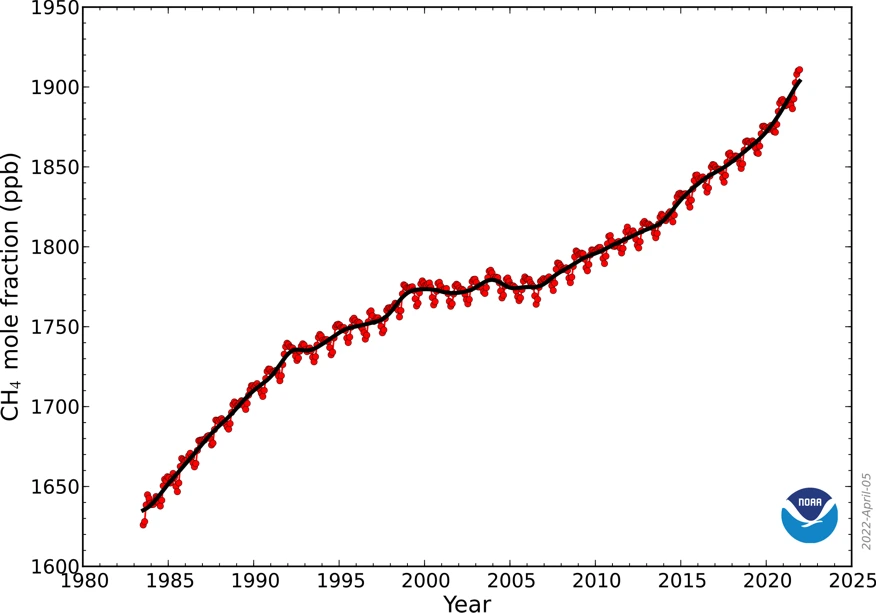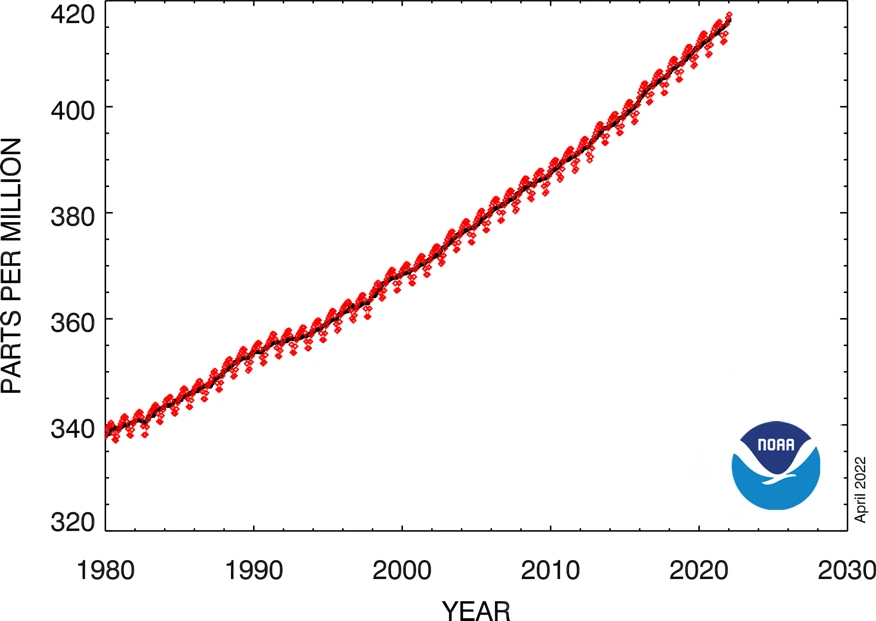NOAA: Atmospheric methane, carbon dioxide increase at record rates
12 April 2022
The US National Oceanic and Atmospheric Administration (NOAA) announced that analysis of data from their global sampling network showed that levels of the potent greenhouse gas methane recorded the largest annual increase ever observed in 2021, while carbon dioxide continued to increase at historically high rates.
For the second year in a row, NOAA observed a record annual increase in atmospheric levels of CH4, a greenhouse gas that is the second biggest contributor to global warming after CO2. NOAA’s preliminary analysis showed the annual increase in atmospheric methane during 2021 was 17 ppb, the largest annual increase recorded since systematic measurements began in 1983. The increase during 2020 was 15.3 ppb. Atmospheric methane levels averaged 1,895.7 ppb during 2021, or around 162% greater than pre-industrial levels. From NOAA’s observations, scientists estimate global methane emissions in 2021 are 15% higher than the 1984-2006 period.

Black line is seasonally corrected data
(Source: NOAA)
Meanwhile, levels of carbon dioxide also continue to increase at historically high rates. The global surface average for CO2 during 2021 was 414.7 ppm, which is an increase of 2.66 ppm over the 2020 average. This marks the 10th consecutive year that CO2 increased by more than 2 ppm, which represents the fastest sustained rate of increase in the 63 years since monitoring began.

Black line is seasonally corrected data
(Source: NOAA)
“Our data show that global emissions continue to move in the wrong direction at a rapid pace,” said Rick Spinrad, NOAA Administrator. “The evidence is consistent, alarming and undeniable. We need to build a Climate Ready Nation to adapt for what’s already here and prepare for what’s to come. At the same time, we can no longer afford to delay urgent and effective action needed to address the cause of the problem—greenhouse gas pollution.”
While there’s been scientific debate on the cause of the ongoing surge in methane levels, CO2 emissions has always been the primary driver of human-caused climate change. An estimated 36 billion tons of CO2 were emitted into the atmosphere last year by human activity; roughly 640 million tons of CH4 were emitted during the same period. The atmospheric residence time of methane is approximately nine years, whereas some of the CO2 emitted today will continue to warm the planet for thousands of years, according to NOAA.
Atmospheric levels of CO2 are now comparable to where they were during the mid-Pliocene epoch, around 4.3 million years ago. During that period, sea level was about 23 m (75 ft) higher than today, the average temperature was 3.9°C (7°F) higher than in pre-industrial times, and large forests occupied areas of the Arctic that are now tundra.
“The effect of carbon dioxide emissions is cumulative,” said Pieter Tans, senior scientist with the Global Monitoring Laboratory. “About 40% of the Ford Model T emissions from 1911 are still in the air today. We’re halfway to doubling the abundance of carbon dioxide that was in the atmosphere at the start of the Industrial Revolution.”
While CO2 remains in the atmosphere for much longer than CH4, methane is roughly 25 times more powerful at trapping heat in the atmosphere, and has an important short-term influence on the rate of climate change, NOAA said.
Methane in the atmosphere is generated by many different sources, such as fossil fuel production, transport and use, from the decay of organic matter in wetlands, and as a byproduct of digestion by ruminant animals such as cows. Determining which specific sources are responsible for variations in annual increases of methane is complex, but scientists estimate that fossil fuel production and use contributes roughly 30% of the total methane emissions.
Source: NOAA